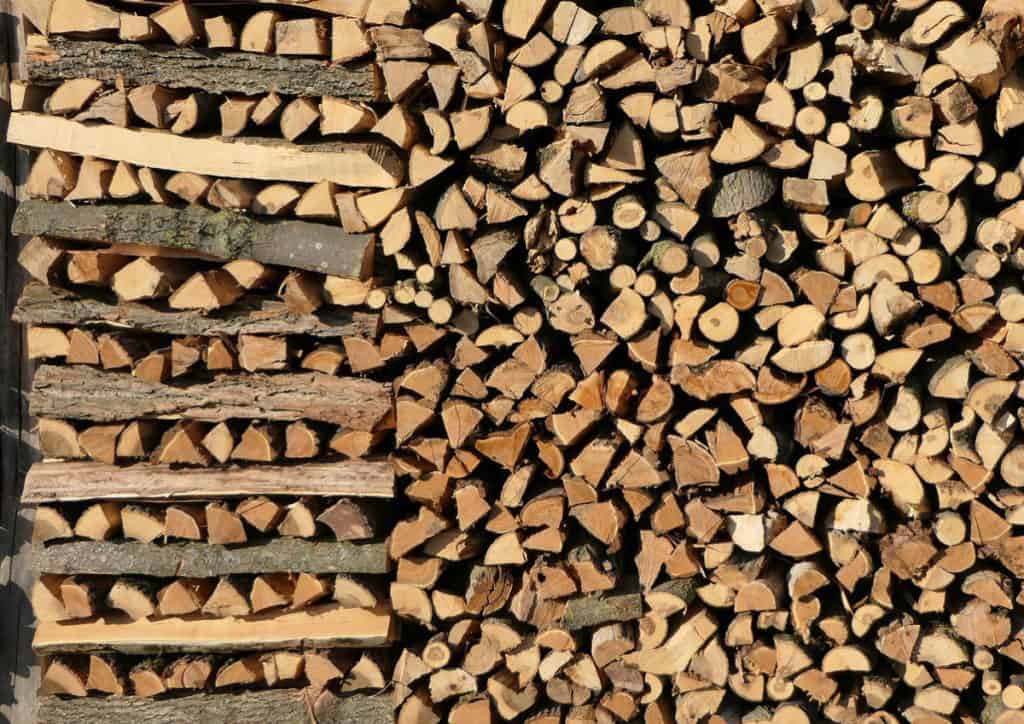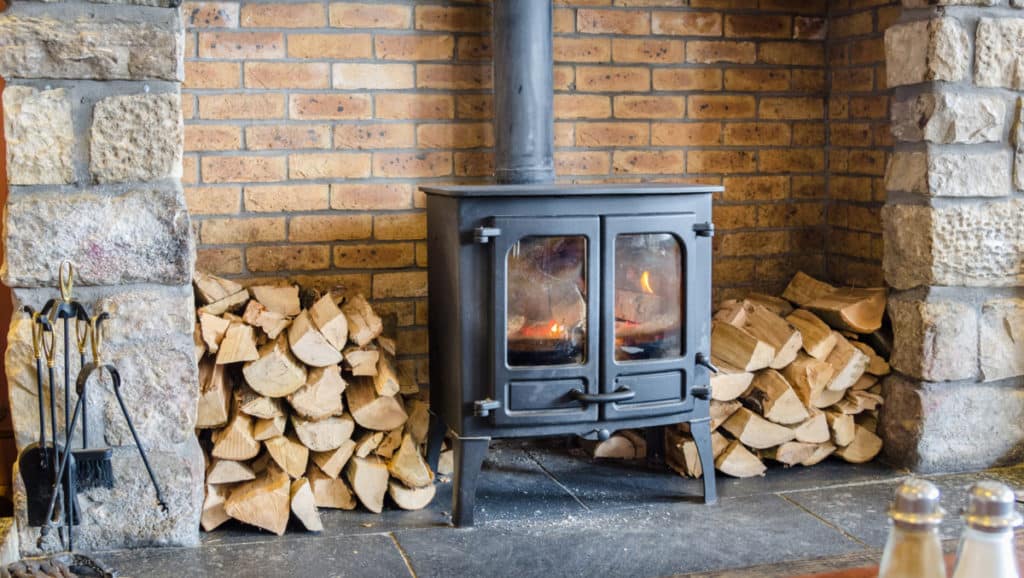
For a long time, I would have my firewood delivered each September or October and trust that it was dry and seasoned. That was until I got burned a couple of times, and now I am cutting, bucking, and stacking my own wood. Even though I’ve been buying, stacking, and burning wood for years, I wanted to research recommendations for knowing when my firewood was seasoned or not. Here are a few things I already knew plus a few newly learned items.
How do I know firewood is seasoned or unseasoned? Below are 15 things to help make this determination.
| 1 | Moisture Meter | The most accurate way to determine whether firewood is dry or seasoned. |
| 2 | Cut Your Own | If you cut, stack, and split your own wood then you’ll know how long it’s been and whether it’s been long enough for it to be dry and seasoned. |
| 3 | Wood Color | The color of the firewood which isn’t a guarantee but more just an indicator that the wood is more seasoned. |
| 4 | Wood Smell | The smell of seasoned wood will be less musty where greener wood will have a more sappy or fresh grass-like smell. |
| 5 | Does it Burn? | If you find it difficult to start a fire there’s a good chance the wood you’re using has a high moisture content. |
| 6 | Weight | Unseasoned green wood will have more moisture and sap, therefore, it will be heavier than dry seasoned wood. |
| 7 | Split Test | Split a few log pieces to determine whether the center of the firewood is dry. |
| 8 | Smoke | If there’s more smoke than usual coming out of your chimney, there’s a good chance you have unseasoned or wet wood in your stove. |
| 9 | Hardness | The dryer and more seasoned wood get, the harder it becomes especially hardwoods such as oak. |
| 10 | Loose Bark | This again is an indication that the tree has been dead for a while but doesn’t necessarily give an accurate account of the wood’s moisture content. |
| 11 | Sound Test | Take two pieces of wood and hit them against one another. Wet unseasoned wood will have a dull thump where dry seasoned wood will have a hollow cracking sound much like the cracking of a baseball bat. |
| 12 | Checks and Cracks | Dry seasoned wood will have more checking and cracking on the ends of each piece of firewood. |
| 13 | Mold or Fungus | Ends of wood have living mold or fungus is a sign of possible high moisture content in the wood. |
| 14 | Growth Rings | Growth rings on seasoned wood will be clearly visible. |
| 15 | Kiln Dried | Kiln-dried firewood is put into an oven-like box that has heat and fans to speed up the drying process of any wood. It may not be what many classify as seasoned but it will be very dry and will burn better. |
What Does It All Mean? Green, Unseasoned, Wet, Seasoned, Dried?
Green wood is much the same as unseasoned wood except that green wood means the tree has been just been cut down and into lengths and bucked.
Unseasoned firewood is wood that has a high moisture level and hasn’t sat long enough to be seasoned. It may have been cut down within a few months but not air dried long enough.
Wet firewood is when there is more than 25% moisture. If the wood is exposed to rain, it can become water-soaked over time especially if the bark has been removed. However, if the wood is already seasoned it’ll dry out within a few days. For green wood to get wet it doesn’t matter because it most likely already has at least a 50% moisture content. A mentioned in the earlier table, the best way to measure your firewood moisture is to use a moisture meter.

This meter is the one I currently use however they’re no longer available here’s the same brand that’ll work the same found on Amazon.
Seasoned wood is that which has sat and aired dried for a season or more. The moisture content in seasoned wood will be 20% or less. The wood can be a gray color and much lighter.
Dried firewood, also known as kiln-dried, is wood that has been placed into a kiln which is a large oven-like box that has a heat source and fans to quickly evaporate the moisture in any greenwood. This type of wood is more expensive but is considered a premium type of firewood with a moisture content of 10 to 15 percent.
How Long Do Various Types Of Wood Take To Become Seasoned?
The longer you can let your firewood sit is always better in the seasoning process.
Below are a list of various woods and the x’s indicate the approximate time it takes to season it. Of course, the region where you live can greatly impact the seasoning time.
| Wood Species | 6 months | 12 months | 18 months | 2+ years |
| Oak | x | x | x | |
| Cherry | x | x | ||
| Maple | x | x | ||
| Alder | x | x | ||
| Walnut | x | x | ||
| Hemlock | x | x | ||
| Ash | x | |||
| Birch | x | |||
| Beech | x | x | ||
| Hickory | x | x | ||
| Pine / Fir | x | x |
Is There a Difference Between Unseasoned and Wet Firewood?
There sure is. Even seasoned wood can get wet and not burn very well but it doesn’t make it unseasoned. Unseasoned wood is simply wood that hasn’t been exposed to air long enough for the water inside to evaporate. The water in unseasoned or uncured wood is located deep within the core of the wood it takes longer for it to be extracted. Where wet wood is mostly affected at a surface level of the wood and typically dries out quicker.
TIP: Do not burn green or wet wood in your indoor fireplace or wood stove as it will end up lining your chimney or flue pipe with flammable tar like substance called creosote that could potentially cause a chimney fire. Read my creosote article to learn more about this subject. It’s more specific to Ponderosa Pine but still applies to any wood not properly seasoned.
Wood Species That Can Be Burned Unseasoned
Well, it’s not recommended to burn any wood species when it’s green. However, if you were in a tight pinch there are a couple of woods that come to mind but only for outdoor burning. Both ash and birch can be burned unseasoned. Of course, you won’t have a very hot fire and I suggest, if possible, burn it with other dryer or seasoned woods. Birch and ash are not a really good firewood source as they burn really fast and do not put out very many BTUs.
Ways to Season Firewood Fast
For me when I stack my wood it’s already seasoned so I’d stack it under a covered carport in rows as high as I could get it. But that was only because I didn’t freshly cut any of my firewood, I’d always have it delivered. Now that I’m in the process of cutting my own I’m learning a few new tricks. It’s best to stack your firewood up off the ground by using something like pallets, which is what I use, or other types of blocks that will raise it around three to six inches. Wood sitting directly on the ground will quickly draw in more moisture and there’s no airflow. When stacking you should keep some spacing between each row. You can cross stack your pieces of firewood on the ends of your rows to create a nice square corner and help to stabilize your rowed piles.
Keep your wood open for as long as you can without covering it. If you’re in a rainy moist area of the country then you’ll want to cover at least the top portion of your wood stack but do not tarp it all the way to the ground. Something I learned the hard way the first year, by tarping all the way to the ground will keep your wood from drying because the airflow becomes restricted. Try to let your wood be exposed to sun and wind for at least six months of the year. If possible, once your wood is seasoned, stack it in a covered area such as a woodshed, carport or open shed type building.
Conclusion
If you’re going to heat with wood on a regular basis each year it’s best to always think at least one year ahead. Cut your firewood this year for next year’s use and keep it organized by stacking greenwood away from the already seasoned wood.

If the wood isn’t completely dried you can also stack this wood in a separate pile near your stove or fireplace to help it to dry out faster. Then have another pile of wood that’s ready to burn.
